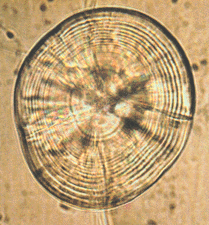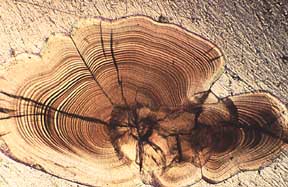Otolith microstructure examinations
How we use otolith deposit growth increments to gain information on fish.
On this page
- Daily growth increments
- Cause of daily increment formations
- Calculating hatch dates
- Examination preparation
- Related links

Daily growth increments in a larval haddock otolith

Daily growth increments in a young sculpin otolith
Daily growth increments
Teleost fish otoliths deposit growth increments with a daily periodicity (daily rings). From this, we can learn precise age and growth information through much of the first year of life.
The formation of daily increments appears to be pervasive across all species and in all environments. The appearance of the increments is often more distinct than that of annuli. As a result, otolith microstructure examinations revolutionized studies of young fish through the 1980s. They’re now routine in many fisheries laboratories around the world.
Cause of daily increment formations
The daily increments form as a result of an endogenous circadian rhythm, or internal clock, which is initially entrained by a 24-hour light-dark cycle. The light-dark cycle isn’t required for daily increment formation after entrainment.
Increments can also be produced by environmental fluctuations, such as:
- feeding
- activity
- temperature variations
These are often referred to as subdaily increments.
However, the environmental cycles more often serve to reinforce the endogenous daily cycle, thus producing clear and regularly-spaced increments in natural environments.
Daily increments don’t appear to form every day only in adult fish and under conditions of poor growth.
Calculating hatch dates
Studies of the otolith microstructure provide much more than just age and growth information. Since the date of fish death (corresponding to the outermost increment in the otolith) is known, the number of daily increments can be used to calculate the exact date of hatch.
Hatch date frequencies in turn can be used to estimate spawning times, based only on collections of juveniles. The ages and dates of certain life history events (such as metamorphosis from the larva to the juvenile) are also recorded in the microstructure. This is shown through the change in increment width and appearance.
Since otolith growth is often proportional to fish growth, the width of a daily increment is roughly proportional to the growth of the fish on that day. Such growth back-calculations are powerful applications of the otolith, and are often used to reconstruct the daily growth history in relationship to the environment.
Other applications include studies of:
- recruitment
- mortality rate
- thermal mass marking
The otolith microstructure can generally be used to provide date or age information to any application, including probe-based elemental analyses.
Examination preparation
All microstructural examinations are towards a view of the internal structure. In very small otoliths (those less than 40 micrometres in diameter), simple microscopic examination on a glass slide may be sufficient.
However, some form of otolith preparation is generally required, such as:
- sectioning
- embedding
- polishing to remove surface material
The end product in both cases is a cross section of the otolith.
Examination of the growth increments is always made with a compound microscope, since increment widths are generally less than 10 micrometres.
Related links
- Date modified: